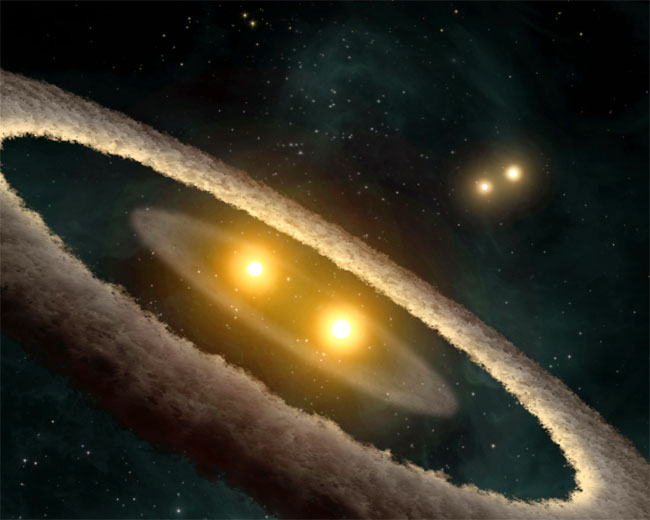
Astronomers have spotted a dusty disk in a four-star solar system that could be home to a planet in the making.
Using the infrared eyes of NASA’s Spitzer Space Telescope, astronomers spotted the swirling disk around a pair of stars in the quadruple-star system HD 98800, located 150 light-years away in the constellation TW Hydrae.
If a planet did form in the disk, its sky would be bathed in the light of four suns. One pair of suns would blaze brightly, while the other pair, gravitationally bound to the first pair, would appear as little more than faint pinpoints of light.
The finding will be detailed in an upcoming issue of The Astrophysical Journal.
So-called “circumstellar” disks like the one that rings HD 98800 can be the birthplace of planets. Most disks are smooth and continuous, but Spitzer detected a gap in the HD 98800 disk that could be evidence of one or more immature “protoplanets” carving out lanes in the dust.
“Planets are like cosmic vacuums,’ said study team member Elise Furlan of the NASA Astrobiology Institute at the University of California, Los Angeles. “They clear up all the dirt that is in their path around the central stars.”
Quadruple sunsets
Get the Space.com Newsletter
Breaking space news, the latest updates on rocket launches, skywatching events and more!
The researchers spied two separate belts of material in the circumstellar disk. One belt sits at 1.5 to 2 astronomical units (AU) from the binary stars and likely consists of fine dust grains. The other is located about 5.9 AU away from and is probably made up of asteroids or comets. (One AU is equal to the distance between the Earth and the sun.) A swath of near-empty space separates the two belts, inside of which a budding planet might roam.
Alternatively, the researchers think the gap could be caused by a gravitational tug-of-war between the system’s four stars. The other two stars are also doubled up, and the two binary pairs are separated by about 50 AU—slightly more than the distance between our sun and Pluto.
“Typically, when astronomers see gaps like this in a debris disk, they suspect that a planet has cleared a path,” Furlan said. “However, given the presence of the diskless pair of stars sitting 50 AU away, the inward-migrating dust particles are likely subject to complex, time-varying forces, so at this point the existence of a planet is just speculation.”
Not uncommon
The stars that make up each stellar doublet orbit around each other, and the two pairs circle one another as well.
Worlds with multiple sunsets are not uncommon. Astronomers used to think that strong gravitational forces from multiple stars might interfere with planet formation, but recent surveys have revealed that the dusty debris disks that function like nurseries for new planets are as common around double star systems as they are around single ones. A few triple-star systems are even known.
“Since many young stars form in multiple systems, we have to realize that the evolution of disks around them and the possible formation of planetary systems can be way more complicated and perturbed than in a simple case like our solar system,” Furlan said.
- Top 10 Most Intriguing Extrasolar Planets
- VIDEO: Worlds with Double Sunsets Abound
- Solar System Makeover: Wild New Theory for Building Planets
Join our Space Forums to keep talking space on the latest missions, night sky and more! And if you have a news tip, correction or comment, let us know at: community@space.com.
Ker Than is a science writer and children's book author who joined Space.com as a Staff Writer from 2005 to 2007. Ker covered astronomy and human spaceflight while at Space.com, including space shuttle launches, and has authored three science books for kids about earthquakes, stars and black holes. Ker's work has also appeared in National Geographic, Nature News, New Scientist and Sky & Telescope, among others. He earned a bachelor's degree in biology from UC Irvine and a master's degree in science journalism from New York University. Ker is currently the Director of Science Communications at Stanford University.










